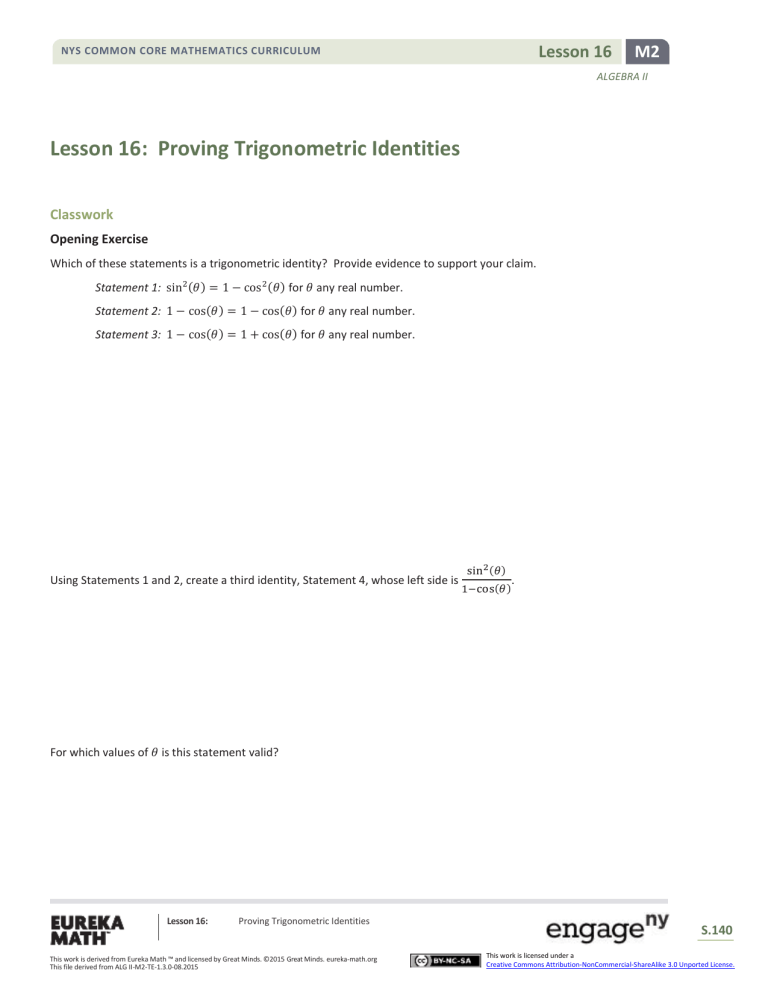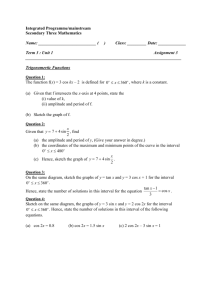Algebra II Module 2, Topic B, Lesson 16: Student Version
advertisement

Lesson 16 NYS COMMON CORE MATHEMATICS CURRICULUM M2 ALGEBRA II Lesson 16: Proving Trigonometric Identities Classwork Opening Exercise Which of these statements is a trigonometric identity? Provide evidence to support your claim. Statement 1: sin2 (𝜃) = 1 − cos 2(𝜃) for 𝜃 any real number. Statement 2: 1 − cos(𝜃) = 1 − cos(𝜃) for 𝜃 any real number. Statement 3: 1 − cos(𝜃) = 1 + cos(𝜃) for 𝜃 any real number. Using Statements 1 and 2, create a third identity, Statement 4, whose left side is sin2 (𝜃) . 1−cos(𝜃) For which values of 𝜃 is this statement valid? Lesson 16: Proving Trigonometric Identities This work is derived from Eureka Math ™ and licensed by Great Minds. ©2015 Great Minds. eureka-math.org This file derived from ALG II-M2-TE-1.3.0-08.2015 S.140 This work is licensed under a Creative Commons Attribution-NonCommercial-ShareAlike 3.0 Unported License. Lesson 16 NYS COMMON CORE MATHEMATICS CURRICULUM M2 ALGEBRA II Discuss in pairs what it might mean to “prove” an identity. What might it take to prove, for example, that the following statement is an identity? sin2 (𝜃) 1−cos(𝜃) = 1 + cos(𝜃) where 𝜃 ≠ 2𝜋𝑘, for all integers 𝑘. To prove an identity, you have to use logical steps to show that one side of the equation in the identity can be transformed into the other side of the equation using already established identities such as the Pythagorean identity or the properties of operation (commutative, associative, and distributive properties). It is not correct to start with what you want to prove and work on both sides of the equation at the same time, as the following exercise shows. Exercise 1 1. Use a calculator to graph the functions 𝑓(𝑥) = sin(𝑥) + cos(𝑥) and 𝑔(𝑥) = −√1 + 2sin(𝑥)cos(𝑥) to determine whether sin(𝜃) + cos(𝜃) = −√1 + 2sin(𝜃)cos(𝜃) for all 𝜃 for which both functions are defined is a valid identity. You should see from the graphs that the functions are not equivalent. Suppose that Charles did not think to graph the equations to see if the given statement was a valid identity, so he set about proving the identity using algebra and a previous identity. His argument is shown below. First, [1] sin(𝜃) + cos(𝜃) = −√1 + 2 sin(𝜃) cos(𝜃) for 𝜃 any real number. Now, using the multiplication property of equality, square both sides, which gives [2] sin2 (𝜃) + 2sin(𝜃)cos(𝜃) + cos 2(𝜃) = 1 + 2sin(𝜃)cos(𝜃) for 𝜃 any real number. Using the subtraction property of equality, subtract 2sin(𝜃)cos(𝜃) from each side, which gives [3] sin2 (𝜃) + cos 2(𝜃) = 1 for 𝜃 any real number. Statement [3] is the Pythagorean identity. So, replace sin2 (𝜃) + cos 2 (𝜃) by 1 to get [4] 1 = 1, which is definitely true. Therefore, the original statement must be true. Does this mean that Charles has proven that Statement [1] is an identity? Discuss with your group whether it is a valid proof. If you decide it is not a valid proof, then discuss with your group how and where his argument went wrong. Lesson 16: Proving Trigonometric Identities This work is derived from Eureka Math ™ and licensed by Great Minds. ©2015 Great Minds. eureka-math.org This file derived from ALG II-M2-TE-1.3.0-08.2015 S.141 This work is licensed under a Creative Commons Attribution-NonCommercial-ShareAlike 3.0 Unported License. Lesson 16 NYS COMMON CORE MATHEMATICS CURRICULUM M2 ALGEBRA II Example 1: Two Proofs of Our New Identity Work through these two different ways to approach proving the identity sin2 (𝜃) 1−cos(𝜃) = 1 + cos(𝜃) where 𝜃 ≠ 2𝜋𝑘, for integers 𝑘. The proofs make use of some of the following properties of equality and real numbers. Here 𝑎, 𝑏, and 𝑐 stand for arbitrary real numbers. Reflexive property of equality Symmetric property of equality Transitive property of equality Addition property of equality Subtraction property of equality Multiplication property of equality Division property of equality Substitution property of equality Associative properties Commutative properties Distributive property 𝑎=𝑎 If 𝑎 = 𝑏, then 𝑏 = 𝑎. If 𝑎 = 𝑏 and 𝑏 = 𝑐, then 𝑎 = 𝑐. If 𝑎 = 𝑏, then 𝑎 + 𝑐 = 𝑏 + 𝑐. If 𝑎 = 𝑏, then 𝑎 − 𝑐 = 𝑏 − 𝑐. If 𝑎 = 𝑏, then 𝑎 ⋅ 𝑐 = 𝑏 ⋅ 𝑐. If 𝑎 = 𝑏 and 𝑐 ≠ 0, then 𝑎 ÷ 𝑐 = 𝑏 ÷ 𝑐. If 𝑎 = 𝑏, then 𝑏 may be substituted for 𝑎 in any expression containing 𝑎. (𝑎 + 𝑏) + 𝑐 = 𝑎 + (𝑏 + 𝑐) and 𝑎(𝑏𝑐) = (𝑎𝑏)𝑐. 𝑎 + 𝑏 = 𝑏 + 𝑎 and 𝑎𝑏 = 𝑏𝑎. 𝑎(𝑏 + 𝑐) = 𝑎𝑏 + 𝑎𝑐 and (𝑎 + 𝑏)𝑐 = 𝑎𝑐 + 𝑏𝑐. Fill in the missing parts of the proofs outlined in the tables below. Then, write a proof of the resulting identity. a. We start with the Pythagorean identity. When we divide both sides by the same expression, 1 − cos(𝜃), we introduce potential division by zero when cos(𝜃) = 1. This will change the set of values of 𝜃 for which the identity is valid. PROOF: Step Left Side of Equation 1 sin2 (𝜃) + cos 2(𝜃) 2 sin2 (𝜃) Equivalent Right Side Domain Reason = 1 𝜃 any real number Pythagorean identity = 1 − cos 2 (𝜃) 𝜃 any real number 3 = (1 − cos(𝜃))(1 + cos(𝜃)) 𝜃 any real number 4 = (1 − cos(𝜃))(1 + cos(𝜃)) 1 − cos(𝜃) 5 sin2 (𝜃) 1 − cos(𝜃) 𝜃 ≠ 2𝜋𝑘, for all integers 𝑘 = Lesson 16: Proving Trigonometric Identities This work is derived from Eureka Math ™ and licensed by Great Minds. ©2015 Great Minds. eureka-math.org This file derived from ALG II-M2-TE-1.3.0-08.2015 Substitution property of equality using 1−cos(𝜃) 1−cos(𝜃) =1 S.142 This work is licensed under a Creative Commons Attribution-NonCommercial-ShareAlike 3.0 Unported License. Lesson 16 NYS COMMON CORE MATHEMATICS CURRICULUM M2 ALGEBRA II b. Or, we can start with the more complicated side of the identity we want to prove and use algebra and prior trigonometric definitions and identities to transform it to the other side. In this case, the more complicated expression is sin2 (𝜃) . 1−cos(𝜃) PROOF: Step Left Side of Equation 1 sin2 (𝜃) 1 − cos(𝜃) 2 3 sin2 (𝜃) 1 − cos(𝜃) Equivalent Right Side Domain Reason = 1 − cos 2 (𝜃) 1 − cos(𝜃) 𝜃 ≠ 2𝜋𝑘, for all integers 𝑘 Substitution property of equality using sin2 (𝜃) = 1 − cos 2 (𝜃) = (1 − cos(𝜃))(1 + cos(𝜃)) 1 − cos(𝜃) = 1 + cos(𝜃) Distributive property Exercises 2–3 Prove that the following are trigonometric identities, beginning with the side of the equation that seems to be more complicated and starting the proof by restricting 𝑥 to values where the identity is valid. Make sure that the complete identity statement is included at the end of the proof. 2. tan(𝑥) = sec(𝑥) 𝜋 for real numbers 𝑥 ≠ + 𝜋𝑘, for all integers 𝑘. csc(𝑥) 2 Lesson 16: Proving Trigonometric Identities This work is derived from Eureka Math ™ and licensed by Great Minds. ©2015 Great Minds. eureka-math.org This file derived from ALG II-M2-TE-1.3.0-08.2015 S.143 This work is licensed under a Creative Commons Attribution-NonCommercial-ShareAlike 3.0 Unported License. Lesson 16 NYS COMMON CORE MATHEMATICS CURRICULUM M2 ALGEBRA II 3. 𝜋 2 cot(𝑥) + tan(𝑥) = sec(𝑥) csc(𝑥) for all real numbers 𝑥 ≠ 𝑛 for integer 𝑛. Lesson 16: Proving Trigonometric Identities This work is derived from Eureka Math ™ and licensed by Great Minds. ©2015 Great Minds. eureka-math.org This file derived from ALG II-M2-TE-1.3.0-08.2015 S.144 This work is licensed under a Creative Commons Attribution-NonCommercial-ShareAlike 3.0 Unported License. Lesson 16 NYS COMMON CORE MATHEMATICS CURRICULUM M2 ALGEBRA II Problem Set 1. 2. Does sin(𝑥 + 𝑦) equal sin(𝑥) + sin(𝑦) for all real numbers 𝑥 and 𝑦? 𝜋 2 𝜋 4 3𝜋 ). 4 a. Find each of the following: sin ( ) , sin ( ) , sin ( b. Are sin ( + ) and sin ( ) + sin ( ) equal? c. Are there any values of 𝑥 and 𝑦 for which sin(𝑥 + 𝑦) = sin(𝑥) + sin(𝑦)? 𝜋 2 Use tan(𝑥) = 𝜋 4 𝜋 2 𝜋 4 sin(𝑥) and identities involving the sine and cosine functions to establish the following identities for the cos(𝑥) tangent function. Identify the values of 𝑥 where the equation is an identity. 3. a. tan(𝜋 − 𝑥) = tan(𝑥) b. tan(𝑥 + 𝜋) = tan(𝑥) c. tan(2𝜋 − 𝑥) = −tan(𝑥) d. tan(−𝑥) = −tan(𝑥) Rewrite each of the following expressions as a single term. Identify the values of 𝑥 for which the original expression and your expression are equal: a. cot(𝑥) sec(𝑥) sin(𝑥) b. ( c. d. 4. 1 1 )( ) 1−sin(𝑥) 1+sin(𝑥) 1 1 cos2(𝑥) − cot2 (𝑥) (tan(𝑥)−sin(𝑥))(1+cos(𝑥)) sin3 (𝑥) Prove that for any two real numbers 𝑎 and 𝑏, sin2 (𝑎) − sin2 (𝑏) + cos 2 (𝑎) sin2 (𝑏) − sin2 (𝑎) cos 2(𝑏) = 0. 5. Prove that the following statements are identities for all values of 𝜃 for which both sides are defined, and describe that set. a. cot(𝜃)sec(𝜃) = csc(𝜃) b. (csc(𝜃) + cot(𝜃))(1 − cos(𝜃)) = sin(𝜃) c. tan2 (𝜃) − sin2 (𝜃) = tan2 (𝜃) sin2 (𝜃) d. 4+tan2 (𝑥)−sec2(𝑥) csc2(𝑥) = 3 sin2 (𝑥) 2 e. 6. (1+sin(𝜃)) + cos2(𝜃) 1+sin(𝜃) =2 Prove that the value of the following expression does not depend on the value of 𝑦: cot(𝑦) Lesson 16: tan(𝑥) + tan(𝑦) . cot(𝑥) + cot(𝑦) Proving Trigonometric Identities This work is derived from Eureka Math ™ and licensed by Great Minds. ©2015 Great Minds. eureka-math.org This file derived from ALG II-M2-TE-1.3.0-08.2015 S.145 This work is licensed under a Creative Commons Attribution-NonCommercial-ShareAlike 3.0 Unported License.







